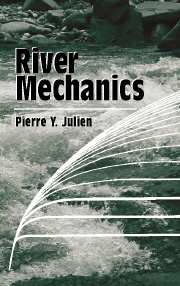Book contents
- Frontmatter
- Contents
- Preface
- Notation
- 1 Introduction to river mechanics
- 2 Physical properties and equations
- 3 River basins
- 4 Steady flow in rivers
- 5 Unsteady flow in rivers
- 6 River equilibrium
- 7 River dynamics
- 8 River stabilization
- 9 River engineering
- 10 Physical river models
- 11 Mathematical river models
- 12 Waves and tides in river estuaries
- Bibliography
- Index
11 - Mathematical river models
Published online by Cambridge University Press: 05 June 2012
- Frontmatter
- Contents
- Preface
- Notation
- 1 Introduction to river mechanics
- 2 Physical properties and equations
- 3 River basins
- 4 Steady flow in rivers
- 5 Unsteady flow in rivers
- 6 River equilibrium
- 7 River dynamics
- 8 River stabilization
- 9 River engineering
- 10 Physical river models
- 11 Mathematical river models
- 12 Waves and tides in river estuaries
- Bibliography
- Index
Summary
Numerous river engineering problems can be conveniently investigated by means of mathematical models. Mathematical models must properly describe the physical processes and provide a numerical solution to a system of differential equations that are solved together with suitable boundary conditions and empirical relationships that describe resistance to flow and turbulence.
The differential equations describing river mechanics problems are usually simplified forms of the equations of conservation of mass and momentum, leading to a set of partial differential equations involving two independent variables (time and space or two spatial variables). Examples that use the finite-difference method are presented in this chapter. The finite-element method also provides useful solutions to river engineering problems but is beyond the scope of this chapter.
The algorithms to be used in the finite-difference method depend on the type of differential equation to be solved. Table 11.1 provides a simple classification of river engineering problems. The information propagates at a celerity c in hyperbolic equations, and the celerity is effectively infinite in parabolic equations.
Once a river engineering problem has been defined and a mathematical model chosen, field data need to be gathered to describe initial and boundary conditions, geometrical similitude, material properties, and design conditions. Additional data are also required for calibration and verification. The governing equations can be simplified to preserve the main features of the physical problem; the time and the space increments are determined at this stage. A schematization can be made of the design conditions to be investigated.
- Type
- Chapter
- Information
- River Mechanics , pp. 352 - 384Publisher: Cambridge University PressPrint publication year: 2002



